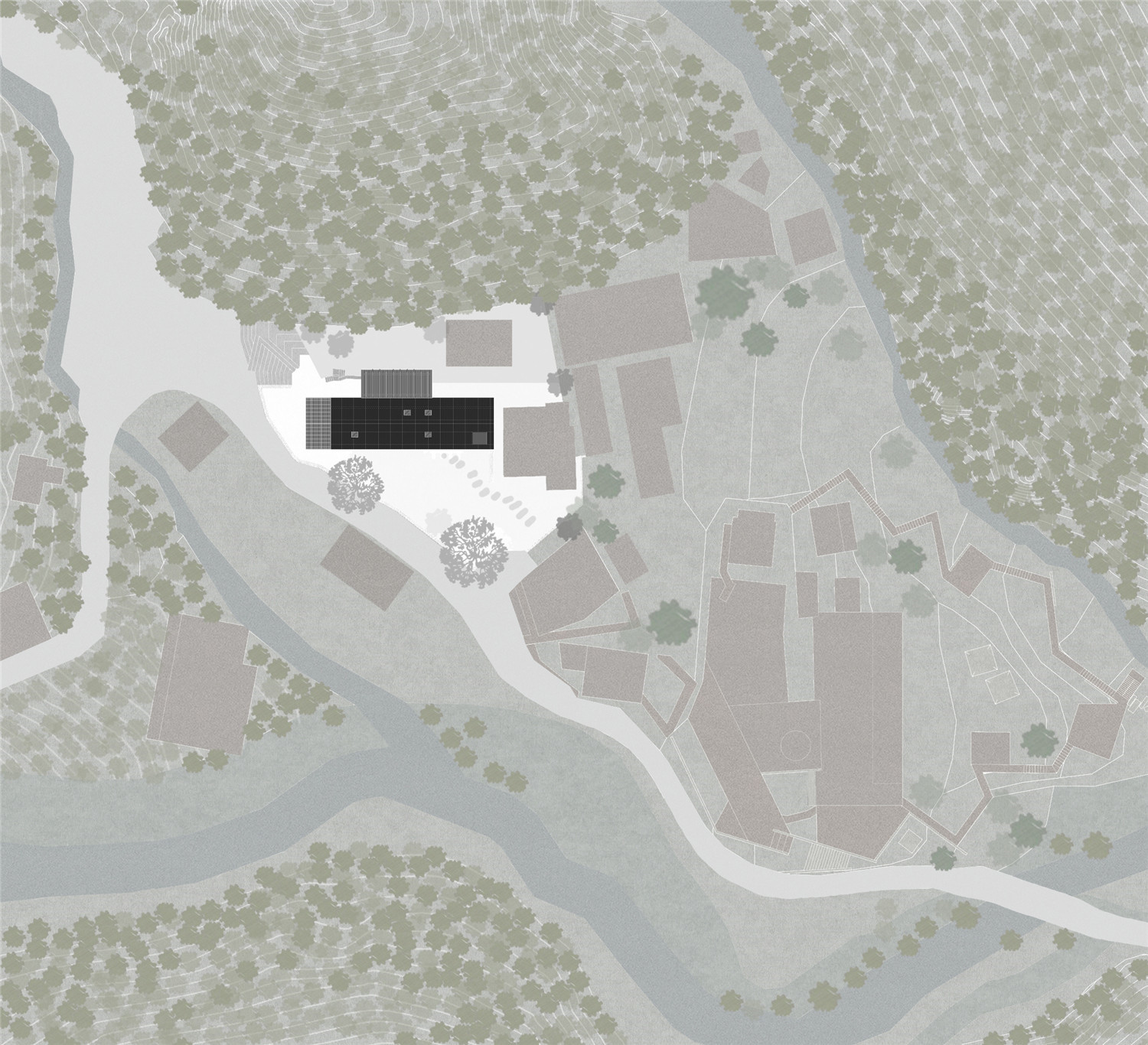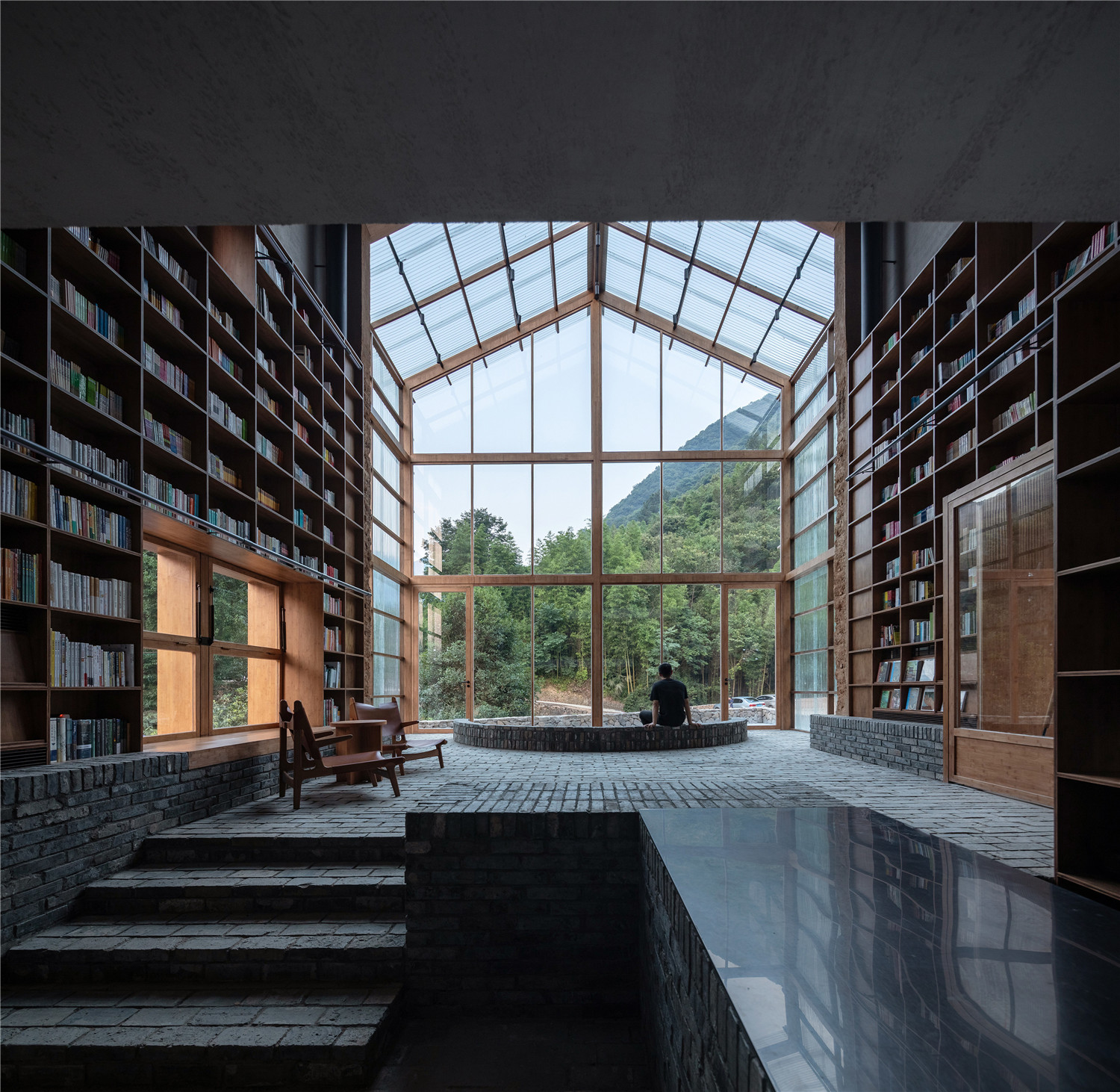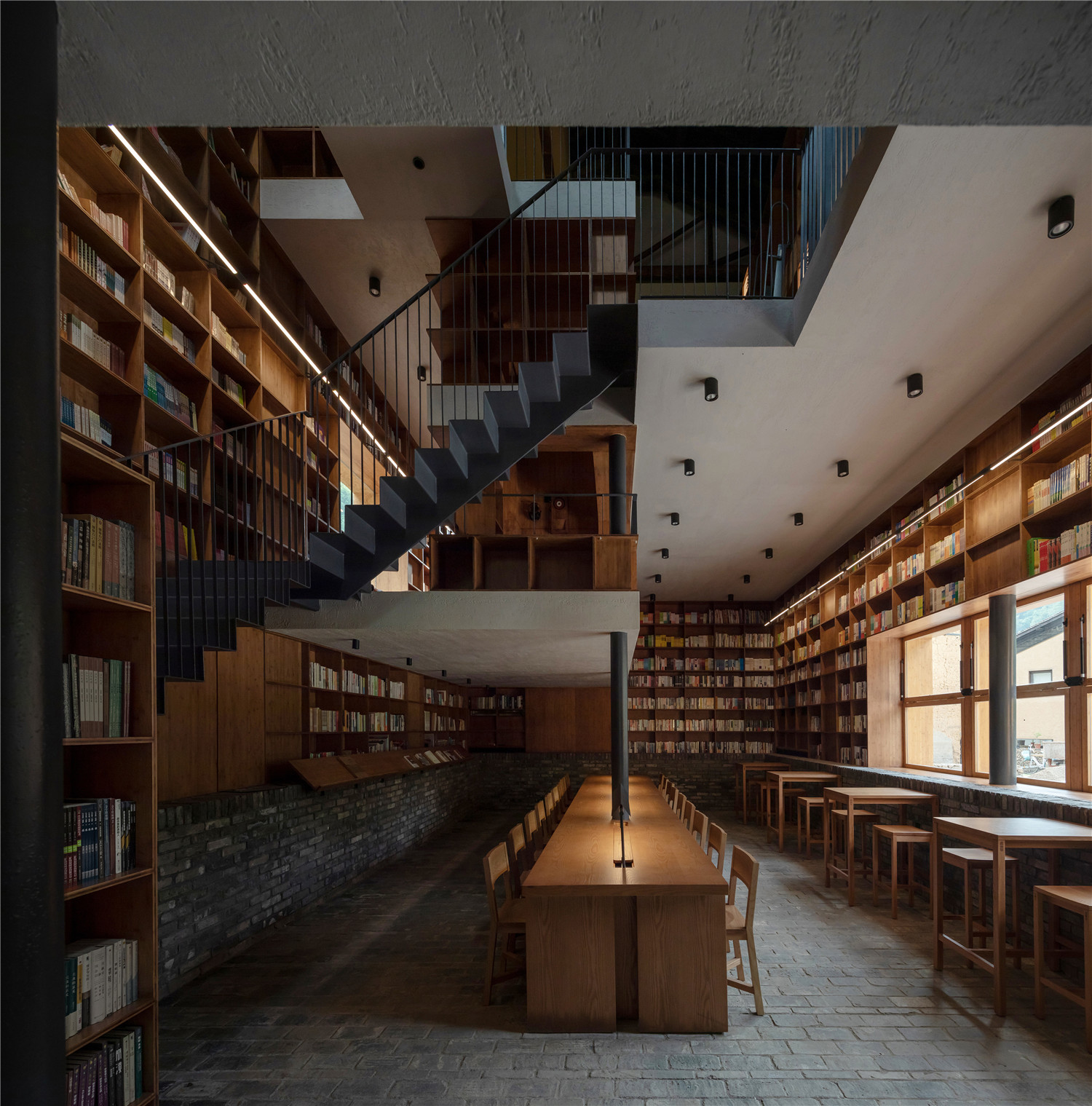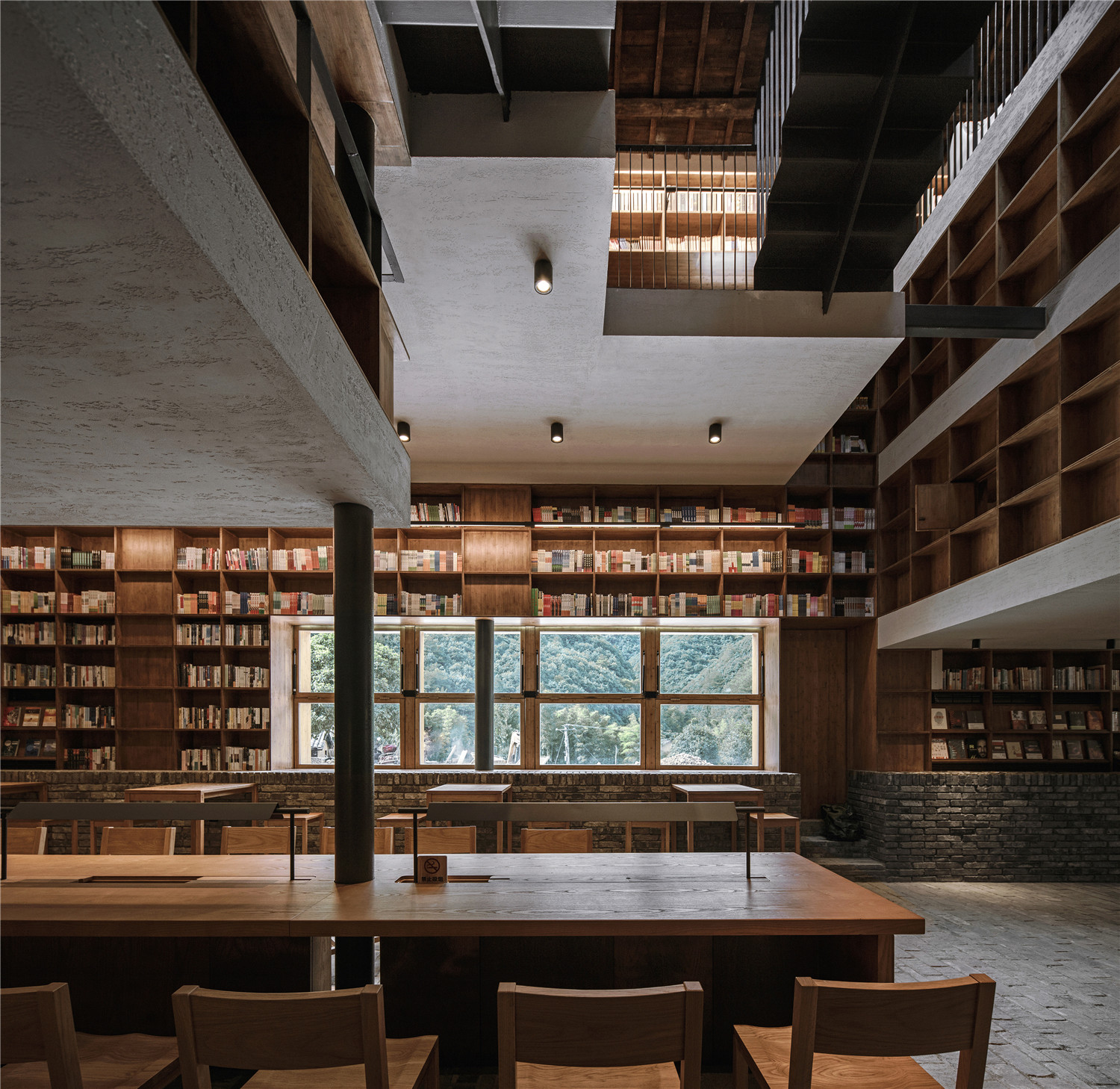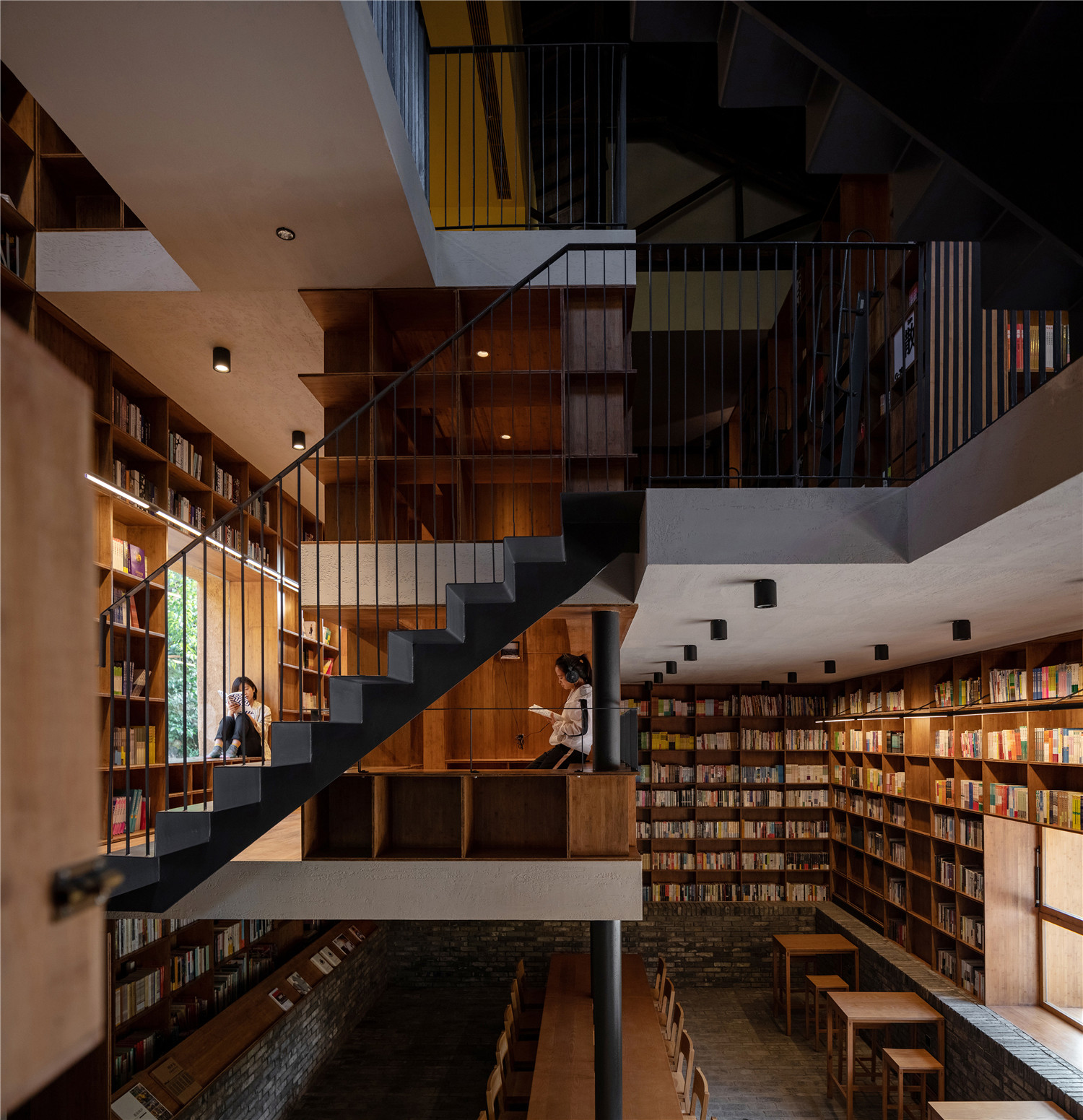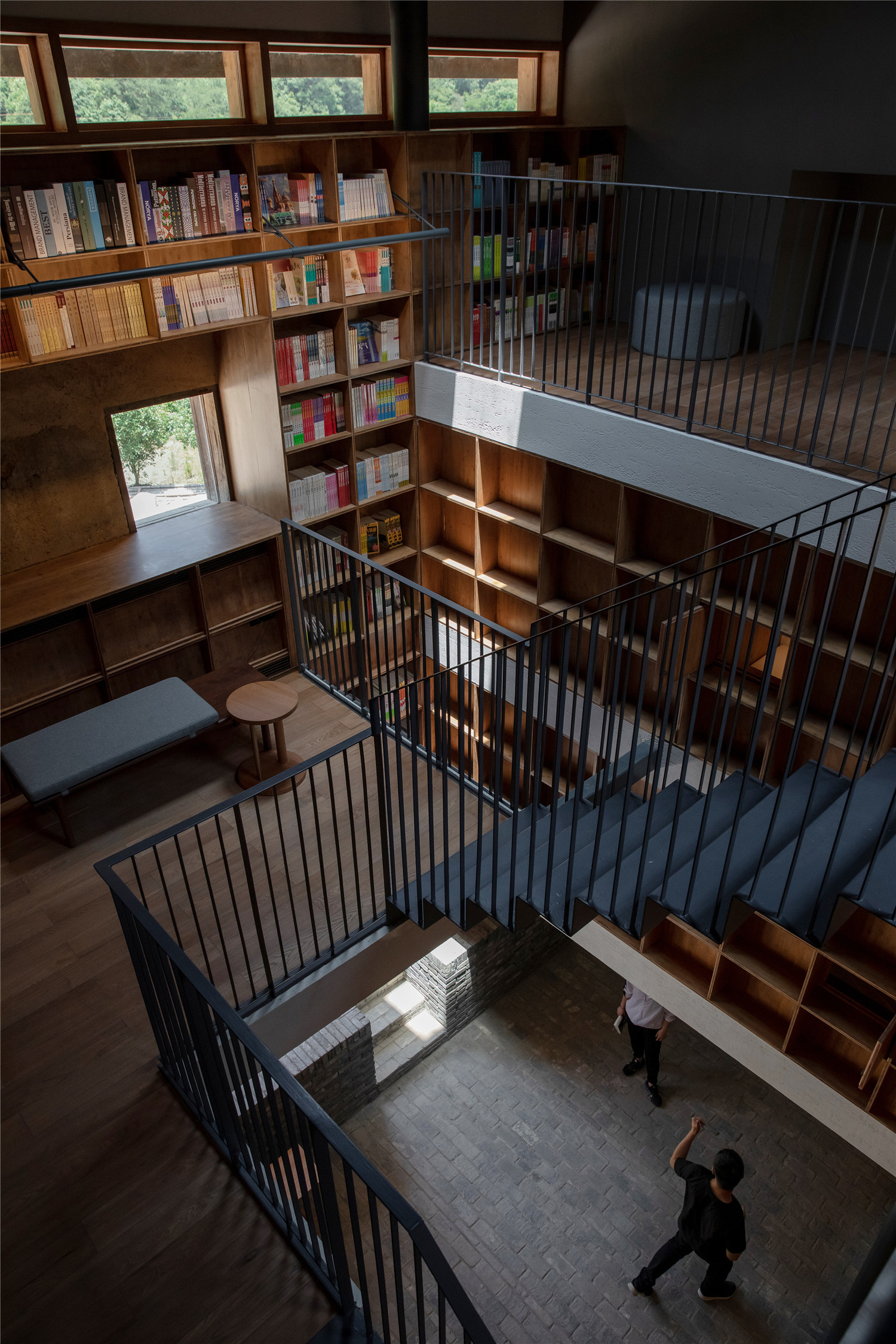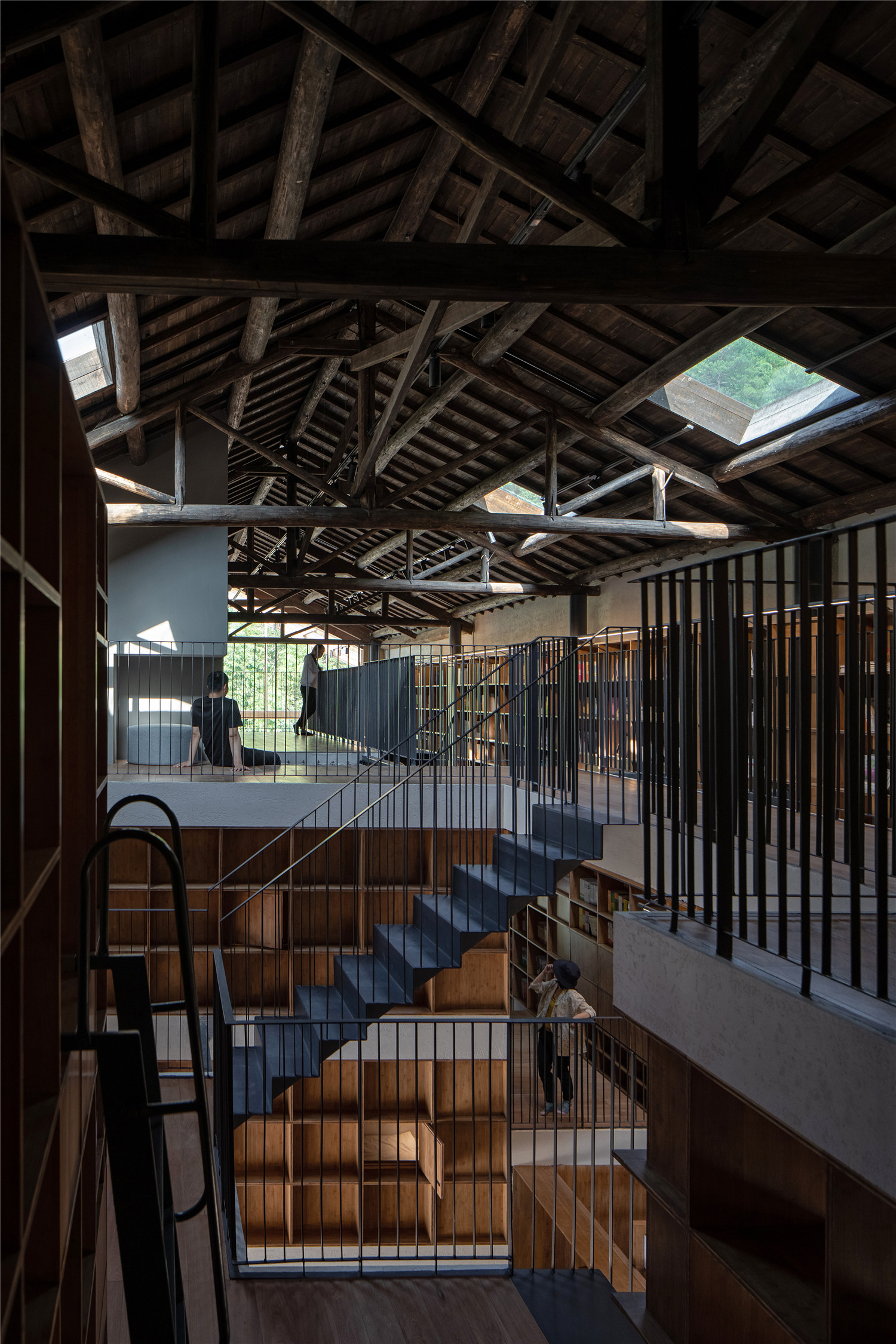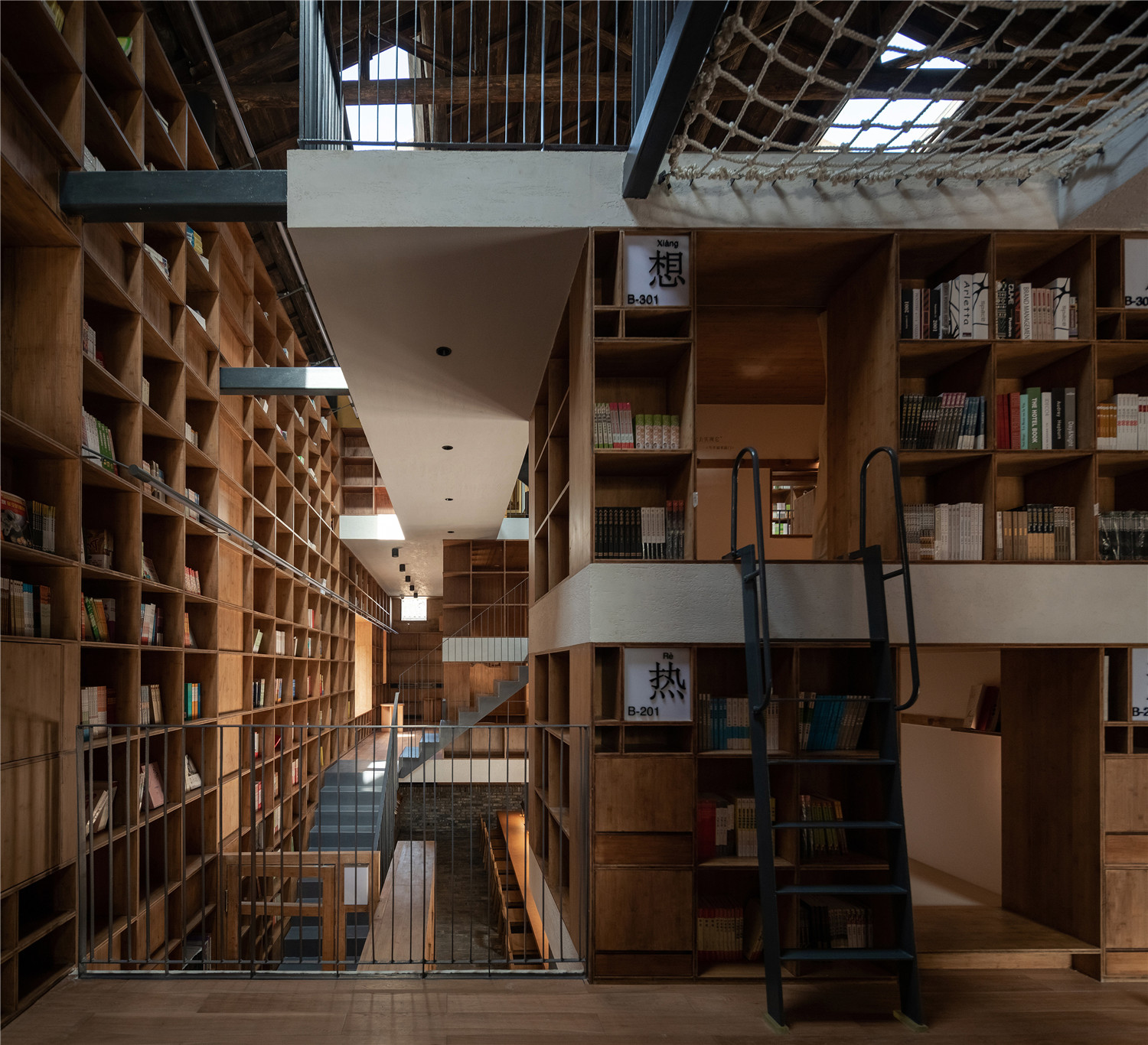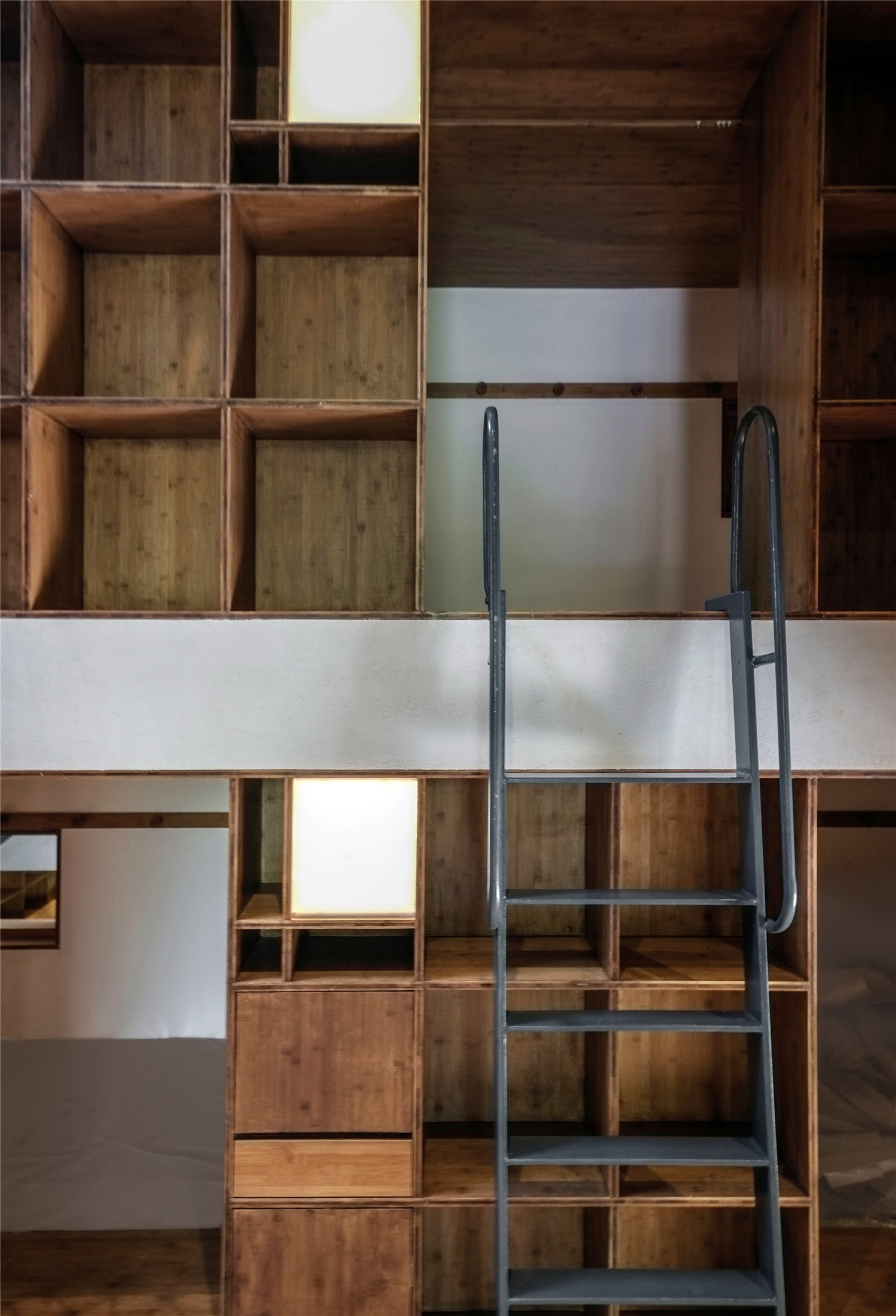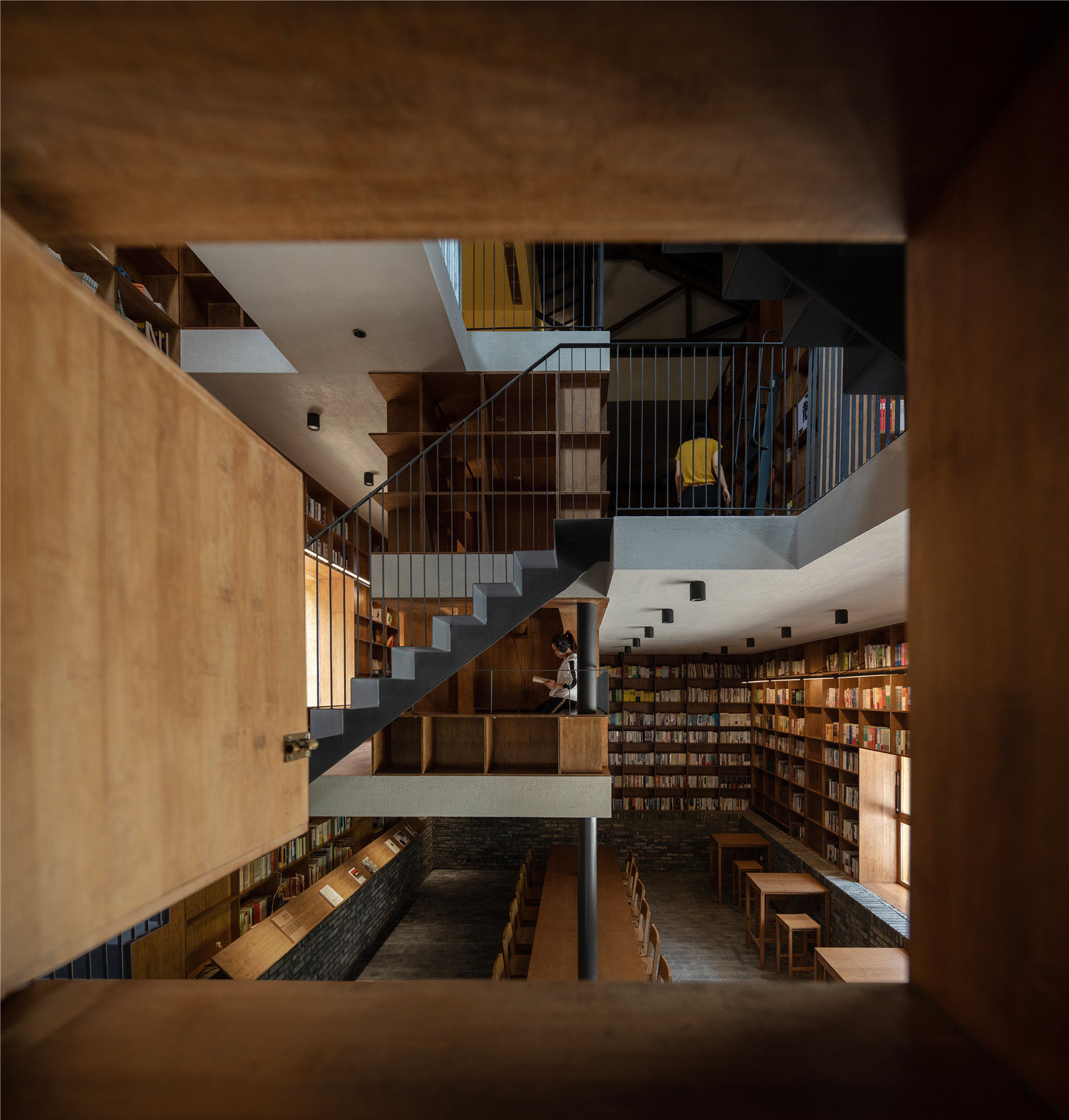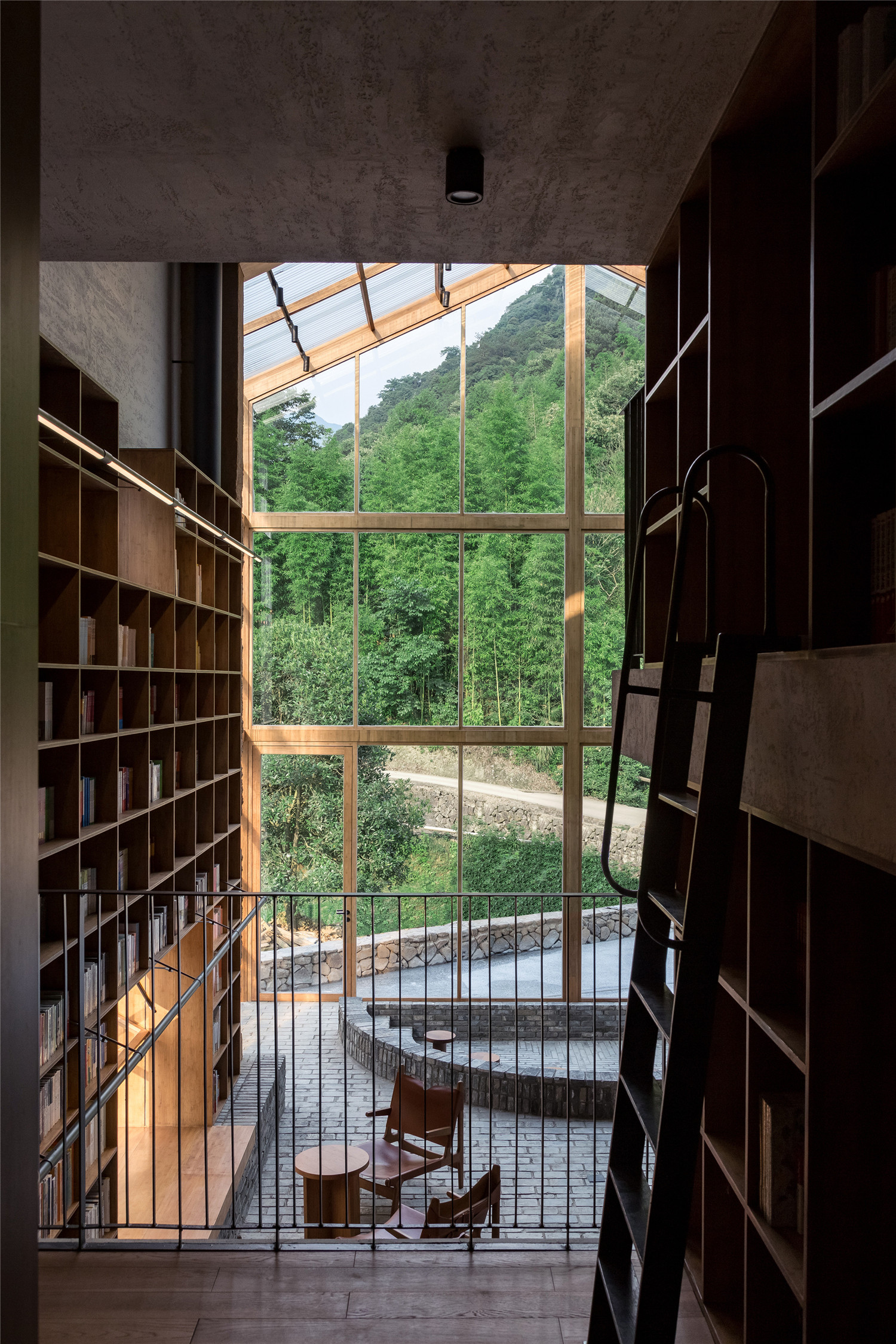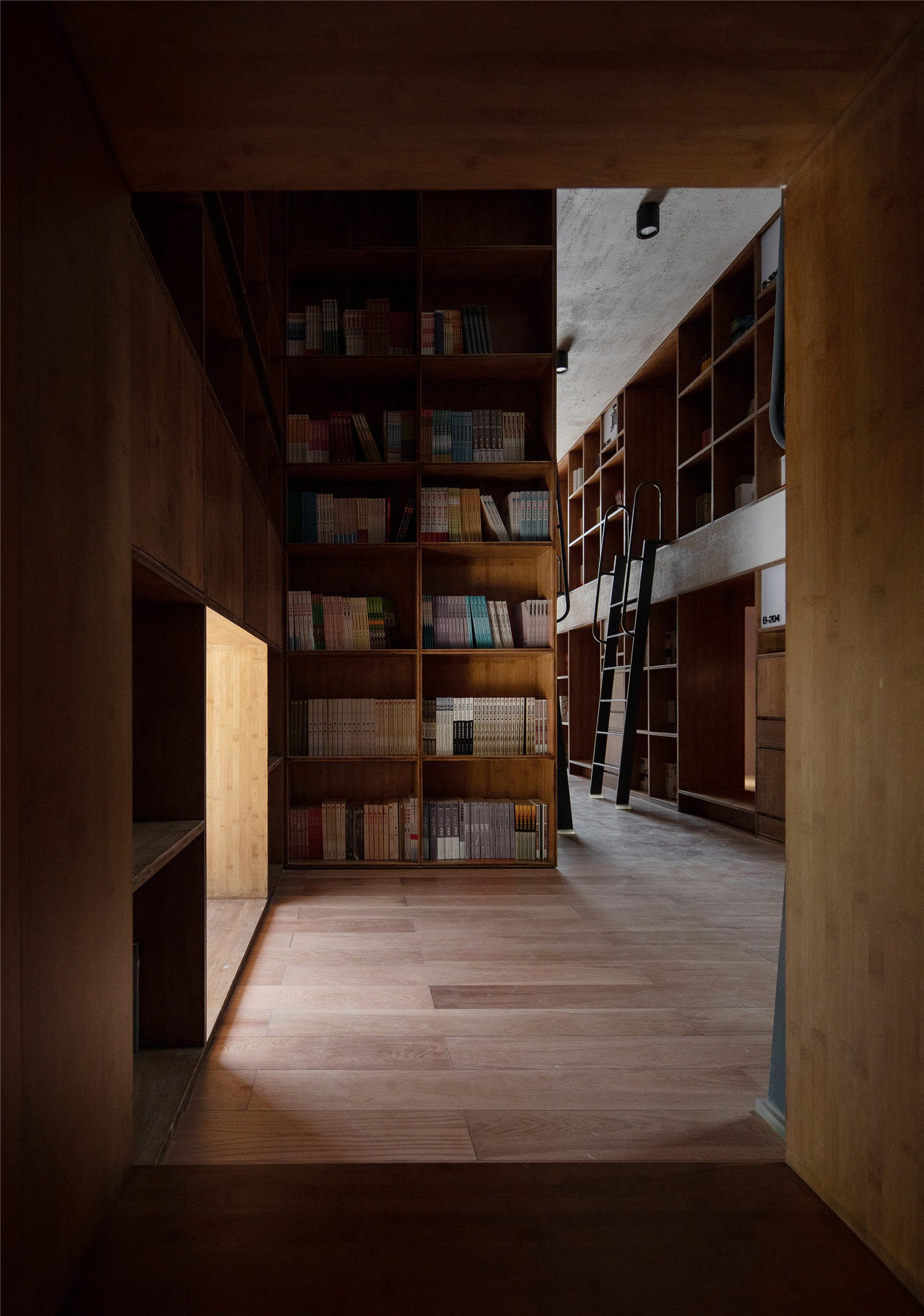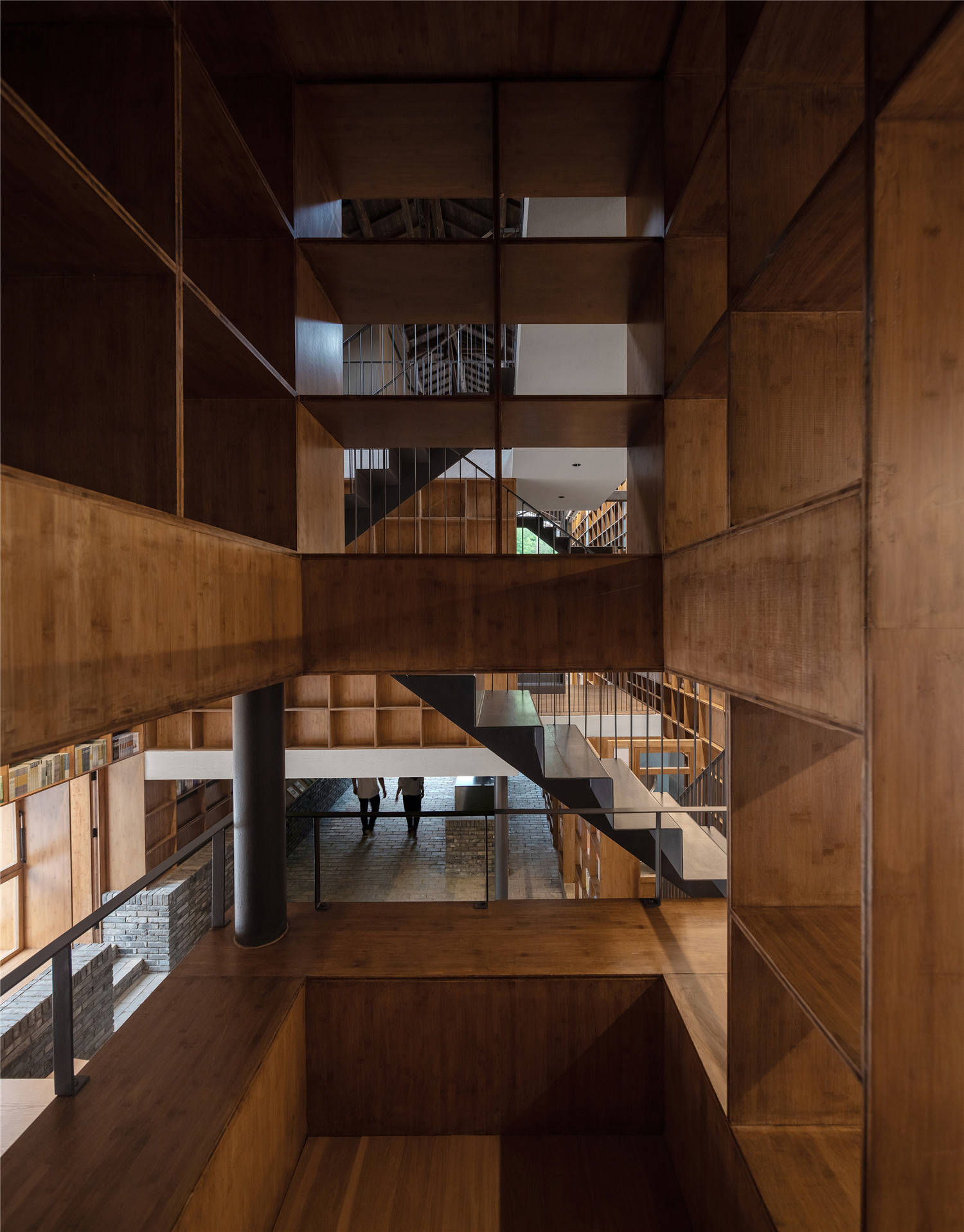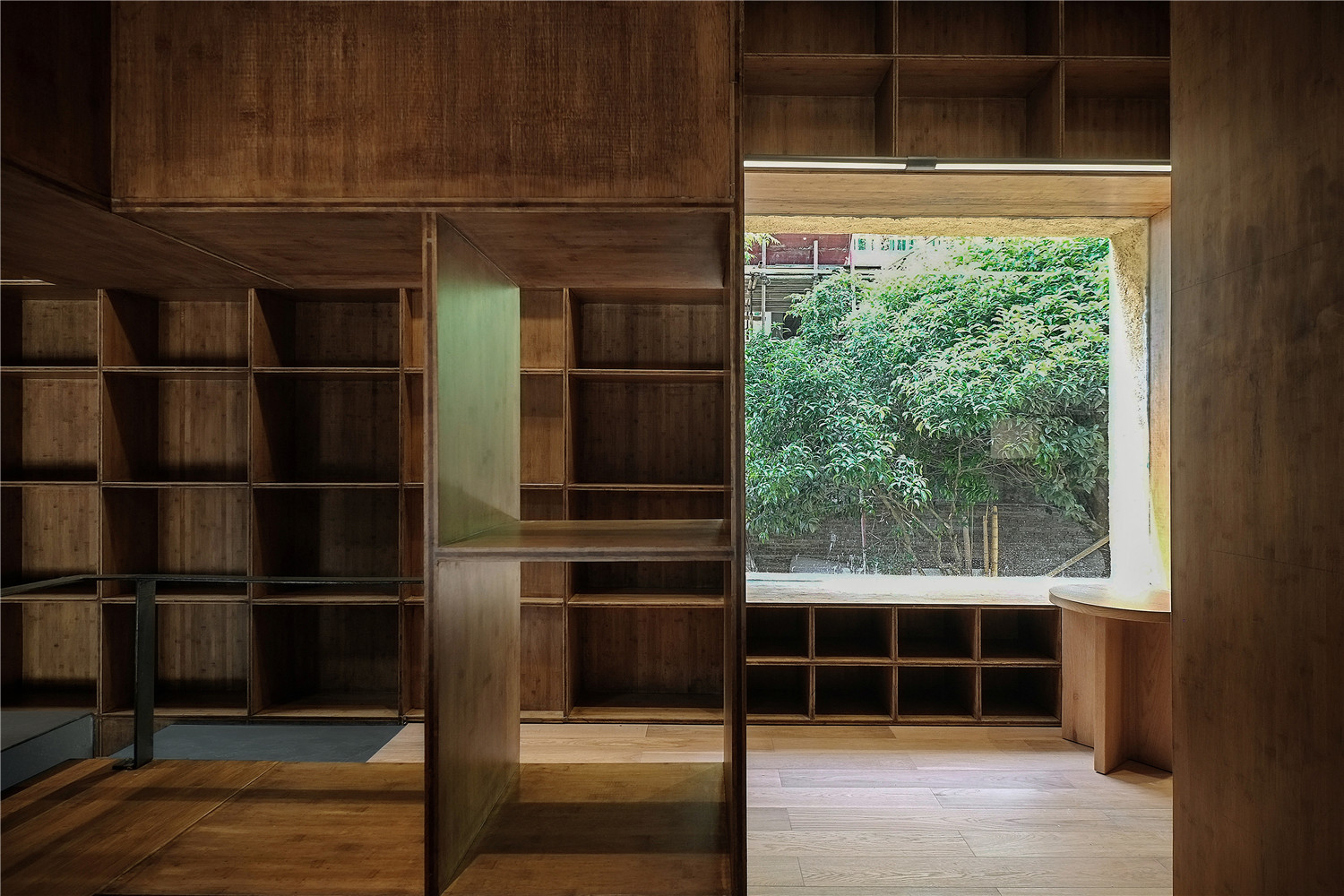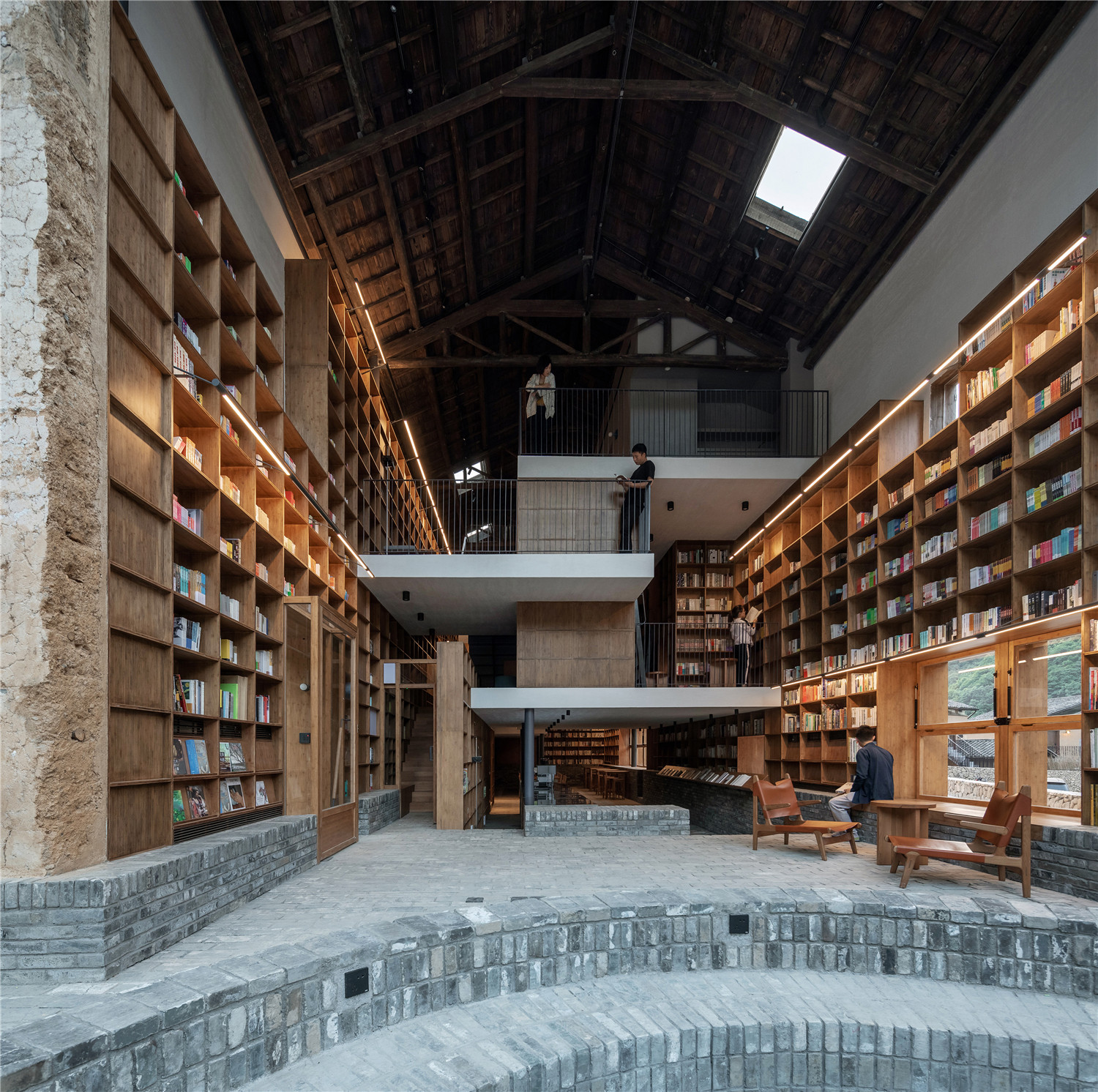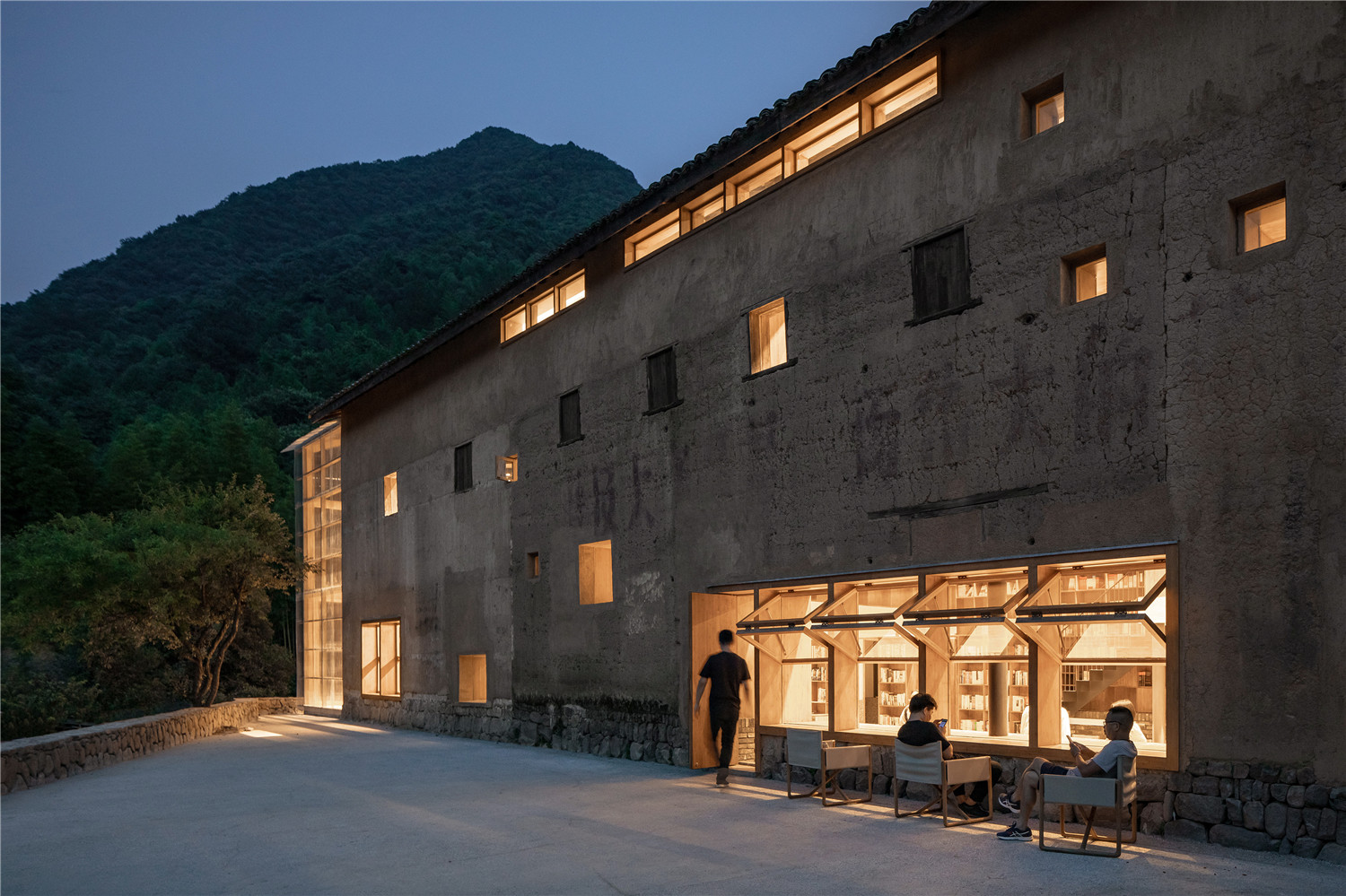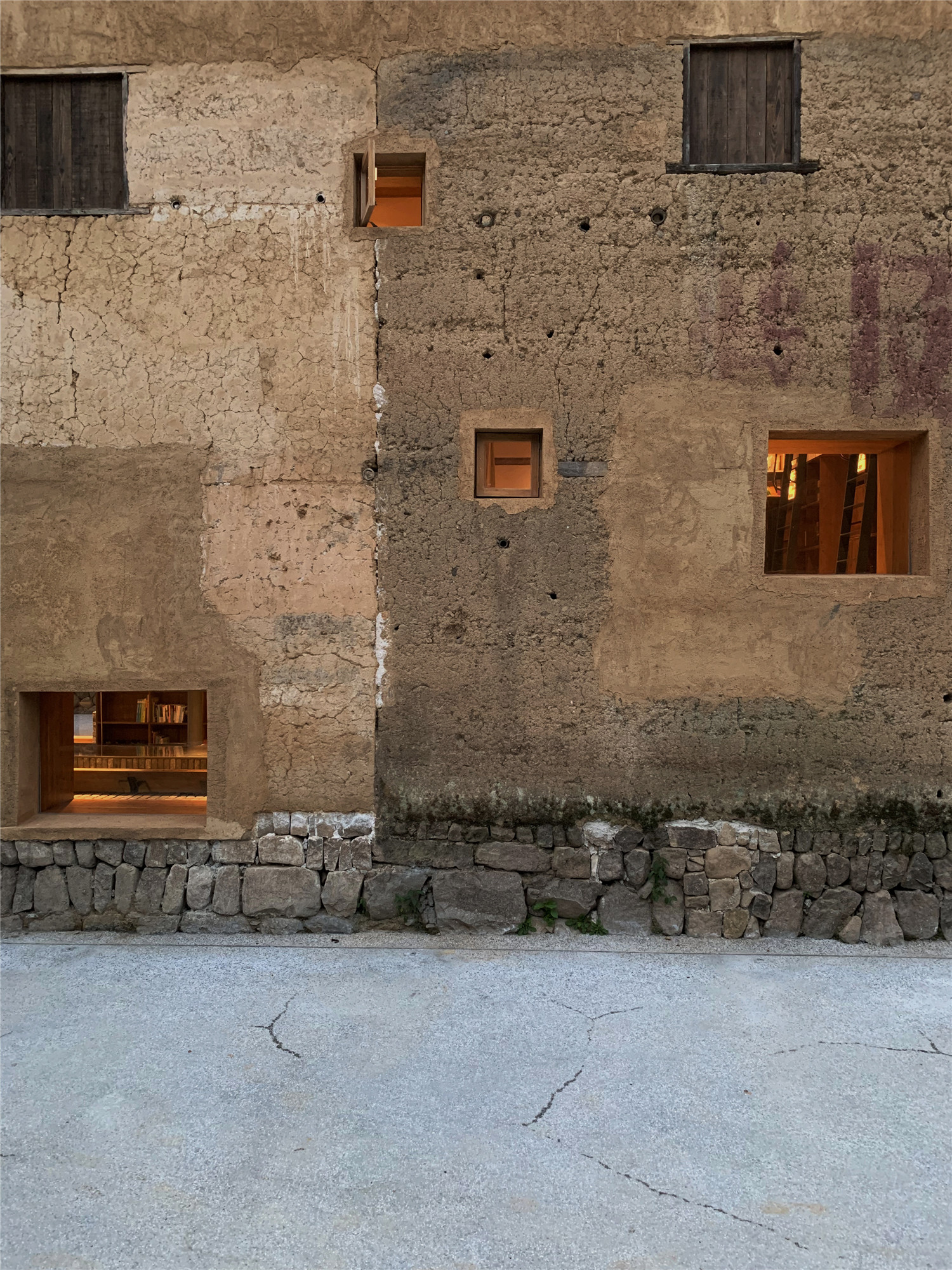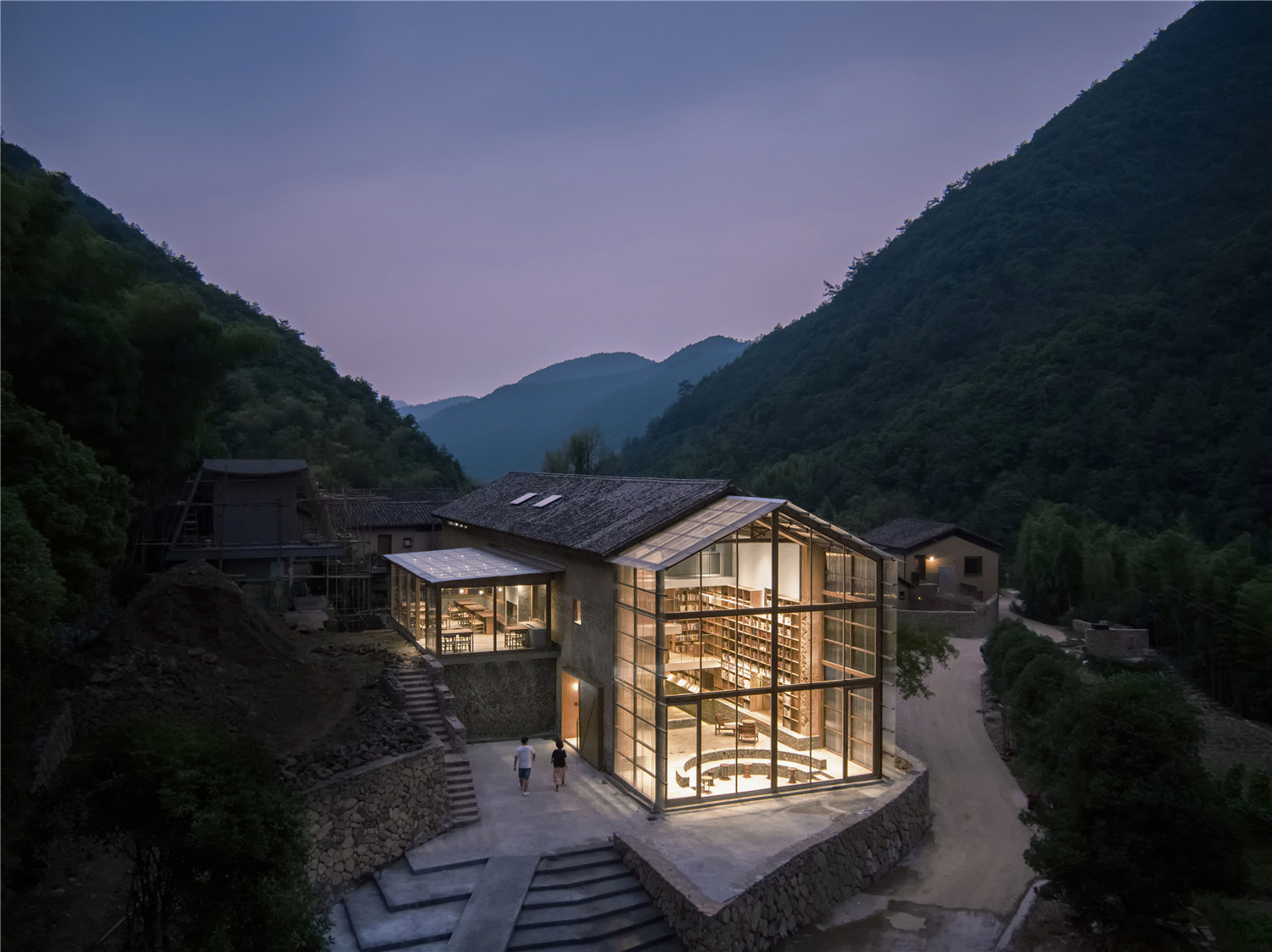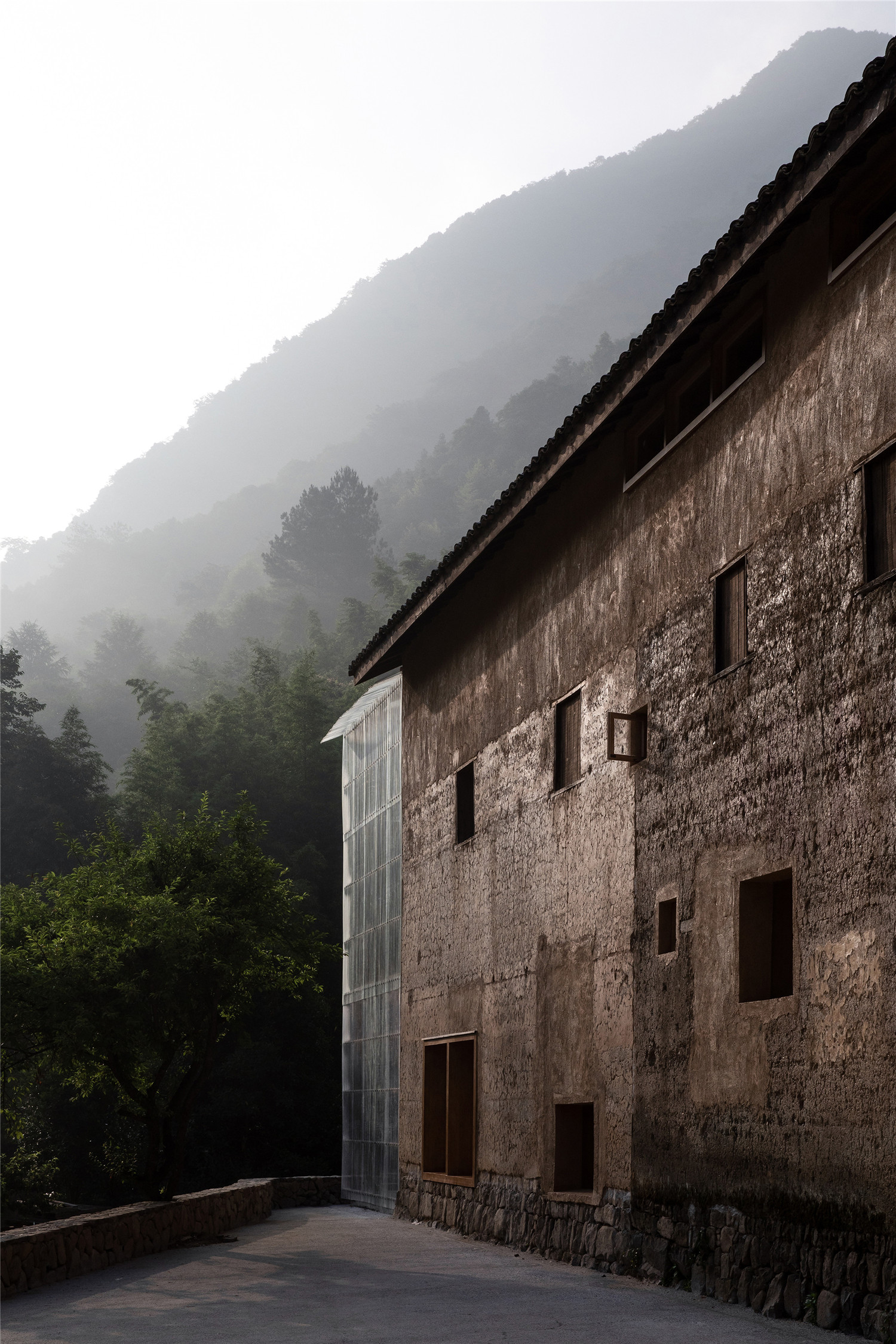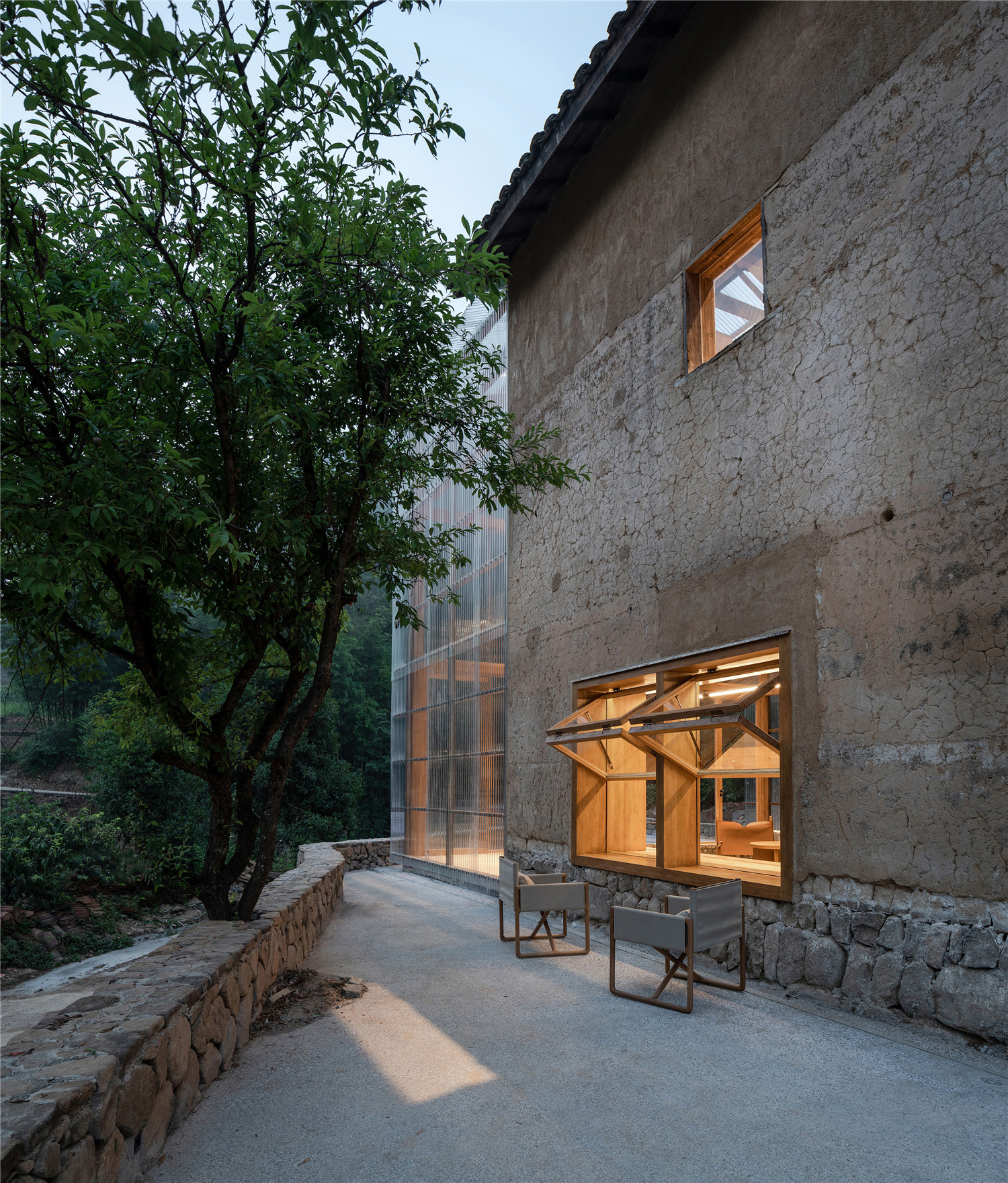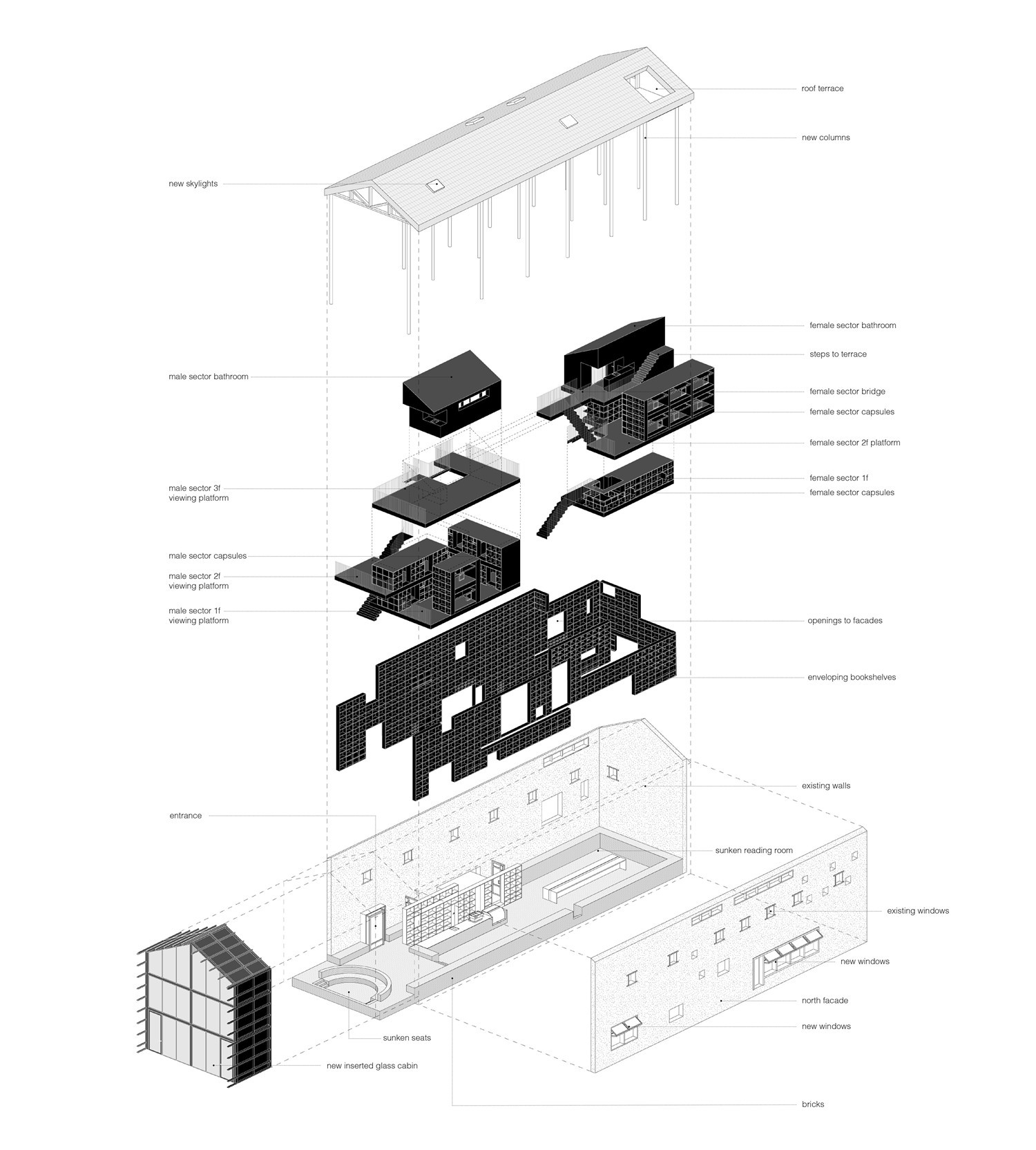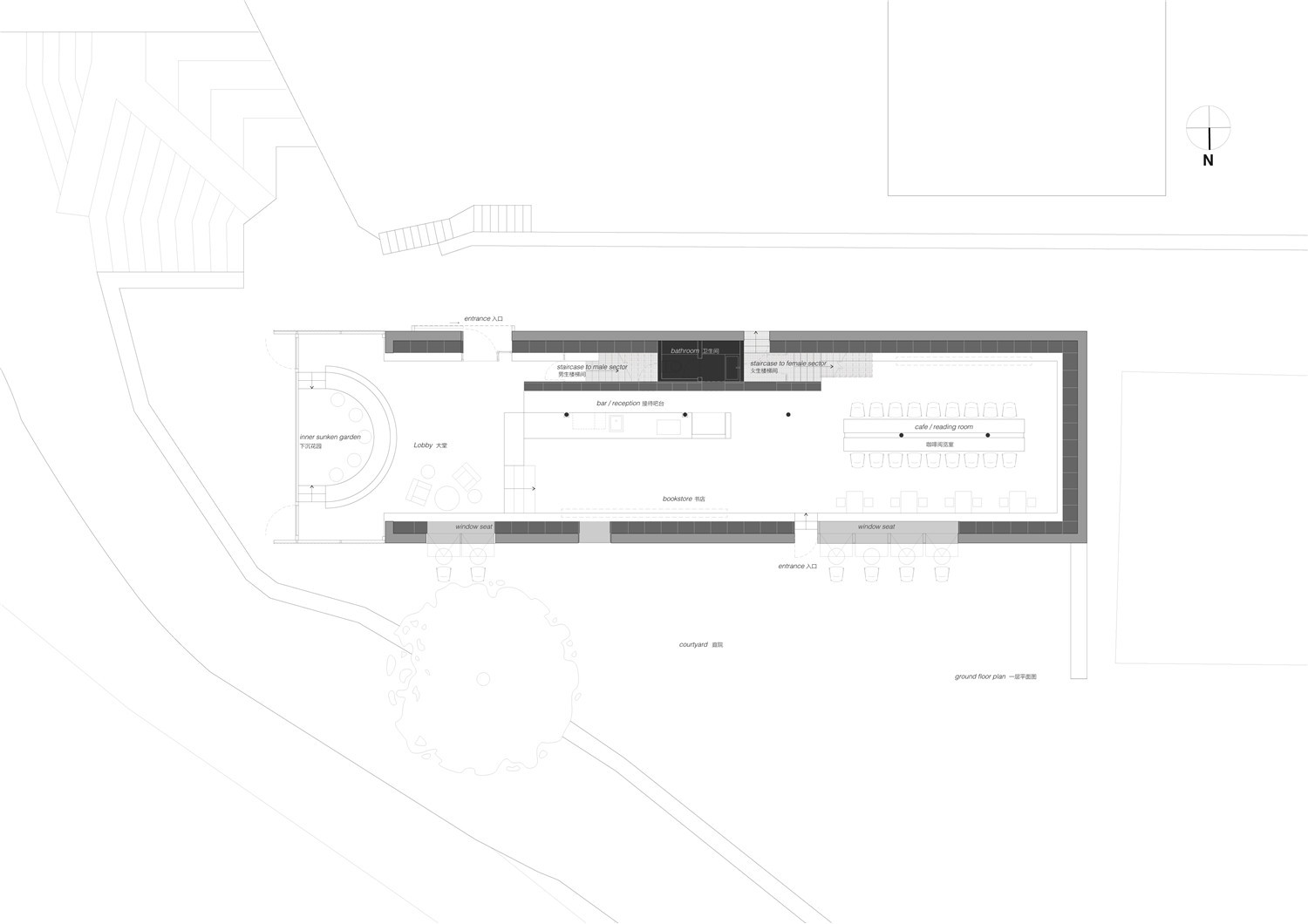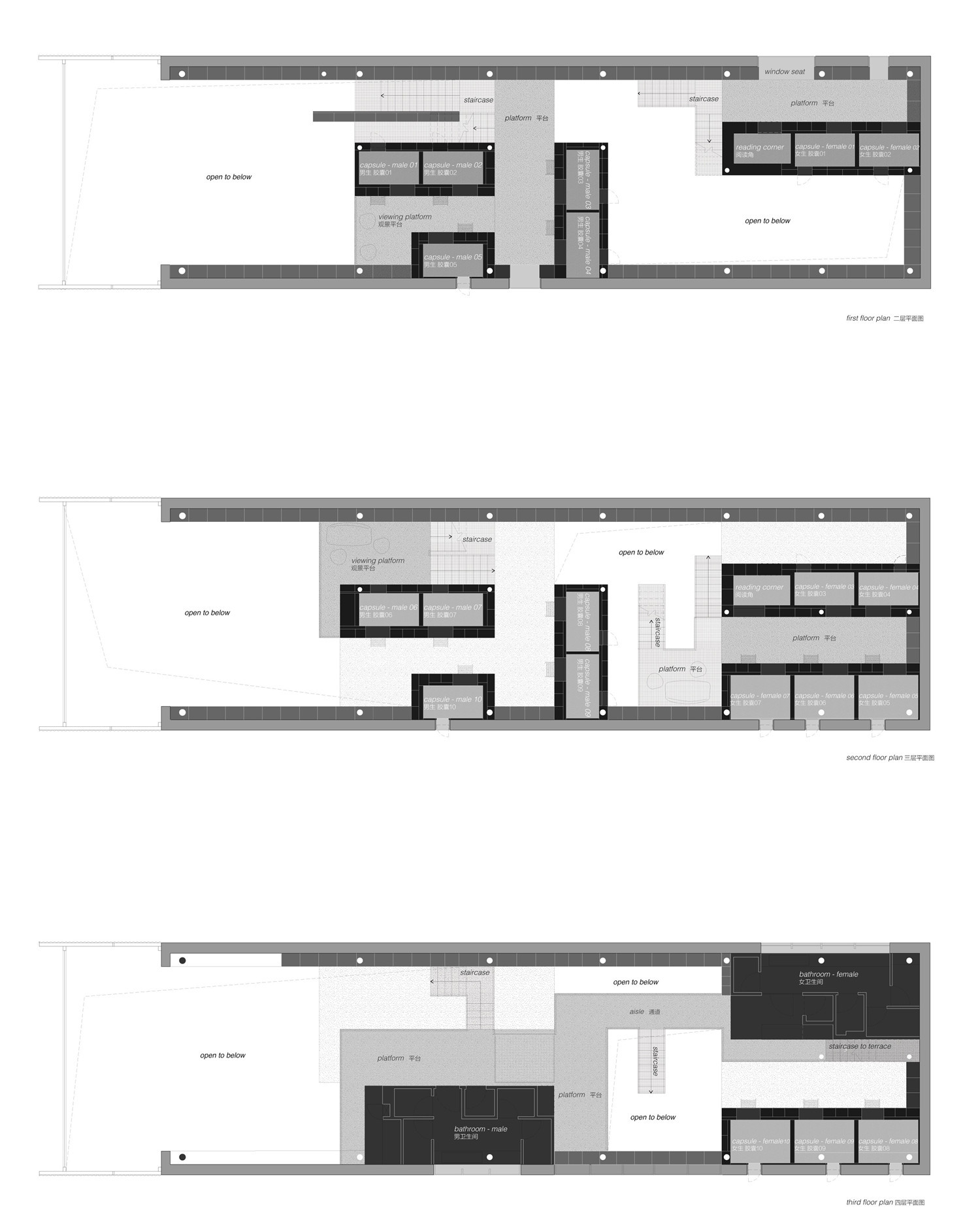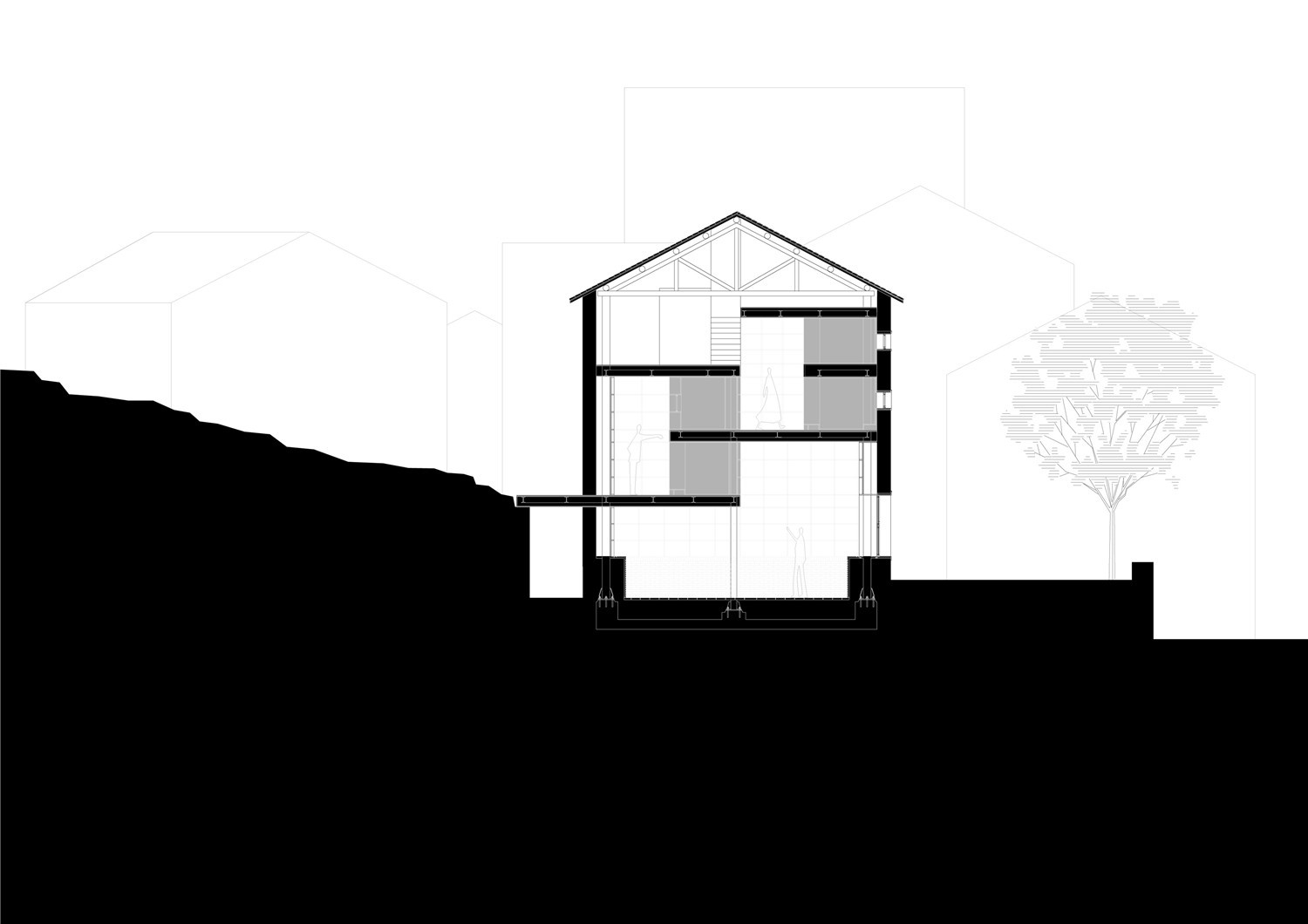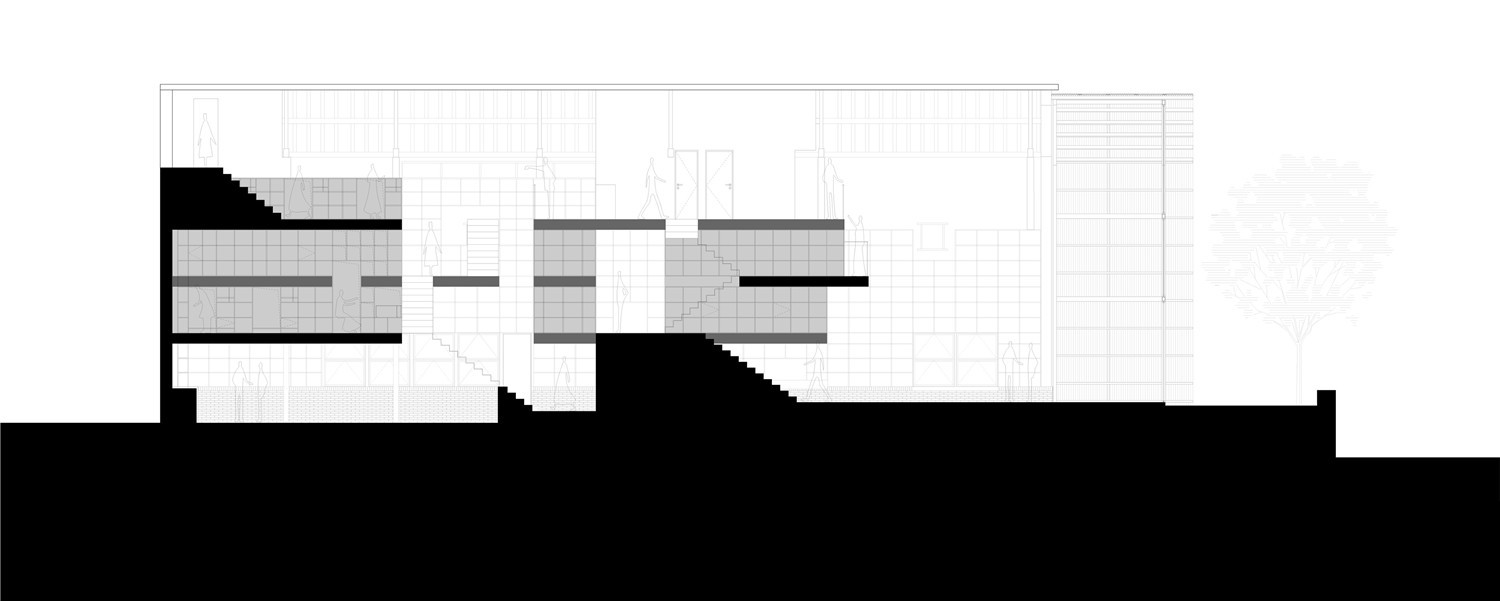青龙坞是一片古村,隐匿在浙江桐庐的山林深处,因流经此地的一条溪水而得名。村中有一座木骨泥墙的老宅,紧邻一条山路,南面背靠青山,北面俯拥低台院落。Ateliertao+c西涛设计工作室应业主之邀改造这座老宅,在占地仅232平米、高7.2米的双层空间中,置入一个可容纳20人的胶囊旅社、一个乡村社区书店和阅览室。如何在一个紧凑空间里保证住宿区的私密性,又要同时满足公共空间的开放性和整体空间的连续性,是这个项目带来的最大挑战,也是建筑师在设计过程中最为关注的问题之一。
Hidden in the deep forests of Tonglu in Zhejiang province, Qinglongwu is an ancient village named after a stream passing through. An old house of wood structure and mud walls is entrenched along a road in the village, facing the green mountains in the south and east side and a lower courtyard in the north. Commissioned by the client, Atelier tao+c redesigned and regenerated this 232sqm old building by inserting a capsule hotel that can accommodate 20 people, a community bookstore and library into the 7.2-meter high two-stories space. The biggest challenge to the architects, and the key to the design, is to ensure the privacy of the accommodation area while giving openness and continuity to the public areas within such a compact space.
▲项目区位图
▲图书馆 东面景观
▲阅览室
▲阅览室看向男生楼
▲阅览室上的女生楼
▲女生楼平台,看向男生楼
▲男生楼平台,看向女生楼
▲转折的路径
▲天光与桥
▲顶楼廊道
在拆除了老宅原有的楼板和隔墙后,一楼作为图书馆和公共区域。建筑师在空间中置入了两个“漂浮”的独立结构,分别用作男生“楼”和女生“楼”。在为客房区域分层时,建筑师没有采用常规的楼层高度,而是特地用坐卧所需的高度–1.35米–作为胶囊住宿区二层以上的楼板高度,以堆叠的形式构成三层“楼中楼”,制造出有趣的视角和不同寻常的空间尺度;同时,住宿区楼板之间相互交错,在部分区域构成“双层”挑高,满足住客通行和站立的需要。当人们站在平台上时,他的视点高度超过了上一层楼板的高度。随之而来,跌宕错落的平台内交织着层次丰富的视线关系,两座“楼中楼”之间可以发生多角度的对望,互通声气,在感官上营造出流动的空间。错层的平台之间通过看似纤薄但结构稳固的金属楼梯相连,每段台阶仅有9步,造成短促转折的穿行路线,有如山中的婉转幽径,人就在这辗转中漫游,攀爬、静止、阅读、窥视、入“囊”休息……置身其中,不见全貌,却在每一处停顿和转身时捕捉到不同的景观,在这一片室内的山水园林中寻趣。
After removing the original floors and partition walls, the architect opened the ground floor for library and open spaces, placed two independent “floating” structure above the open spaces, which will be used separately for male and female guests. Instead of a regular floor height, the architect divided the floating mass by 1.35 meters, a height that can only allow people to sit or to lie low, then split and staggered the floor slabs to create an unconventional three-floor space with interesting perspectives. At the same time, the staggering floor slabs formed a few “double-height” spaces in the accommodation areas, so the hotel guests can still find a place to stand and to walk through, it is also where people’s point of sight is above the floor height. The staggering platforms are intertwined with multiple layers of visual connections, sounds and eye contacts through the two masses, creating a space of floating senses. The split and stacked floors are connected by seemingly thin but stable metal staircases. The stairs, with only 9 steps for each section, formed a zigzagging route with quick turns, it is in fact quite similar to the paths in the mountains where moments of people’s meandering, ascending, stopping, reading, snooping and resting in the capsules are revealed from time to time. One cannot see the whole space when you are inside the space, but you will be able to capture unexpected views wherever you stop or turn back, to explore the fun of lost and found in this indoor “garden”.
▲平台、书架和胶囊
▲交叠的胶囊
▲胶囊的窗景
▲胶囊住宿区看向大厅
▲从胶囊内往外看
▲休息角
▲局部-书架与楼梯
▲局部 窗洞关系
男女楼各配有10个胶囊和一个卫生间,尺寸统一的模块式胶囊客房隐藏于围合的书架之内,形成更为私密的空间。书架取材本地的竹压板,散发清新的竹香。每间胶囊的开窗都恰好与书架的一个格间相对应,形成不同层次的对望和窥视,嗅觉和视觉交糅,制造出一段丰富跌宕的感官旅程。
Each of the male and female “buildings” is equipped with ten capsule rooms and one bathroom. The modular capsule rooms of uniformed size are hidden and enclosed by bookshelves, giving more privacy to the accommodation area. The planks of the bookshelf are made from local bamboo, people can still smell the freshness of the bamboo when they are inside. The window of each capsule room was designed to correspond exactly to a compartment of the bookshelf, coming into different layers of eye contacts and voyeuristic views. What you smell and see in this space are intertwined together to produce an intriguing journey of senses.
▲内部建筑剖面
▲挑空大厅,书架与楼板
▲挑空大厅,书架与波形板房子
▲三楼平台看向大厅
“楼中楼”的构建,模糊了各种空间的边界,与一层的公共空间形成了开放和私密之间的平衡。但从入口大厅处却能看到楼板之间清晰的剖面关系,同时,胶囊区的侧面又与无限重复的书架系统隔空对齐。内与外都变成了相对的概念和互换的体验。
The idea of “buildings inside the building” blurs the boundaries of various spaces and formed a balance between the privacy of the “floating” accommodation area and the openness of the public space on the ground floor. However, when you are looking at the front of the two “buildings” from the entrance hall, you will find a clear cross-section relationship between the staggering floor slabs, while the capsules on the other sides of masses are aligned with the infinitely repeated modular compartments of the bookshelf. It is where the definitions of inside and outside become relative and the experiences become interchangeable.
▲北立面
▲北立面局部
▲南立面开窗
▲清晨的山林与房子
▲有树的一角
建筑外观的改造是室内空间重组的延伸和体现,建筑师依据内部胶囊房间的纵向布局,在外墙上做了克制的开窗,尽量保持建筑原有的质朴。新增的玻璃木窗与夯土墙及原有的旧窗浑然一体;室外地面的青砖也悄然延伸至室内。建筑东面坐拥极佳的自然景观,于是建筑师将东面的整面山墙剖开,嵌入一个由木框架和聚碳酸酯波浪板构成的透明房子,让青山和绿林晕染至室内,屋顶的天窗也增加了室内空间的采光。暮色降临时,室内的灯光透射而出,温存着山村的静夜,书香伴随人迹,凝聚了村民的日常和情感、激活了村落的脉搏,也点亮了新的生活理想。
The exterior renovation is an extension as well as a reflection on the reorganization of the interior spaces. Based on the vertical programming of the capsule rooms, the architects made restrained openings on the exterior wall to maintain the original simplicity of the building. The new glass windows with wooden frames are naturally integrated with the rammed earth wall and the original old windows in the wall; the grey bricks of the outdoor ground are inconspicuously extended into the interior. Given the amazing natural landscape at the east end of the building, the architect cut the whole gable wall on this side and embedded a transparent structure of wooden frames and corrugated polycarbonate panels, introducing the green of the mountains and forests into the interior. The openings in the ceiling also brings rich natural lights into the interior spaces. At twilight, the whole building is illuminated by the light from the indoor, and the building itself becomes a light house, offering a slice of warmth to the calmness of the night. Together with the fragrance of bamboos and books, the building has a power of cohesion that brings together the villagers. It becomes part of their feelings and memories, and will further inspire a new future of life to the village.
▲轴侧图
▲一层平面图
▲二、三、四层平面图
▲剖面图
项目信息——
项目名称:叠室入书山–青龙坞言几又乡村胶囊旅社书店
设计师:Atelier tao+c西涛设计工作室
项目类型:乡村老房改造
场地地址:中国浙江桐庐
完工日期:06.2019
建筑占地面积:232平米
设计团队:刘涛/蔡春燕/刘国雄(项目设计师)/韩立慧(软装设计)
家具灯具合作设计:体物之作TIWUWORKS
产品设计师:赵云、陈晓雯
结构和机电设计:风语筑-朱红中(项目协调);冯猛(结构设计);杨威(暖通设计);万小娇、龚丹、陈新平(水电设计)
摄影师:苏圣亮(特别注明除外)
材料:竹木层压板/青砖/肌理漆/聚碳酸酯波浪板
FF&E:SUNATSIX-休闲椅,体物之作TIWUWORKS-咖啡桌/吧椅/长凳,EDIMASS-椅子,LINIEDESIGN-地毯
施工方:杜清水营造施工项目驻场负责人:廖华荣/敬大国
业主:放语空乡宿文创综合体
Project information——
Project Name: Capsule Hotel and Bookstore in Village Qinglongwu
Architect’s firm: Atelier tao+c
Project Type: Adaptive Reuse
Location: Tonglu, Zhejiang Province, China
Completion Date: June 2019
GFA: 232 sqm
Design team: Tao Liu, Chunyan Cai, Guoxiong Liu, Lihui Han
Furniture and lighting design: TIWUWORKS
Product designer: Yun Zhao, Xiaowen Chen
Structure and MEP consultant: Shanghai Fengyuzhu Culture Technology Co., Ltd.
Photographer: Su Sheng Liang(except for noted)
Key materials: laminated bamboo planks, grey bricks, textured paint, corrugated polycarbonate panels
FF&E: SUN AT SIX – armchair
TIWUWORKS – tables/ bar stool / bench
EDIMASS – chair
LINIEDESIGN – rugs
Contractor: Du Construction
Site managers: Huarong Liao, Daguo Jing
Client: Fang Yu Kong Cultural & Creative Resort Complex



